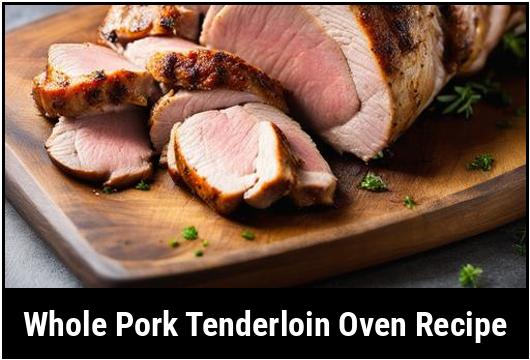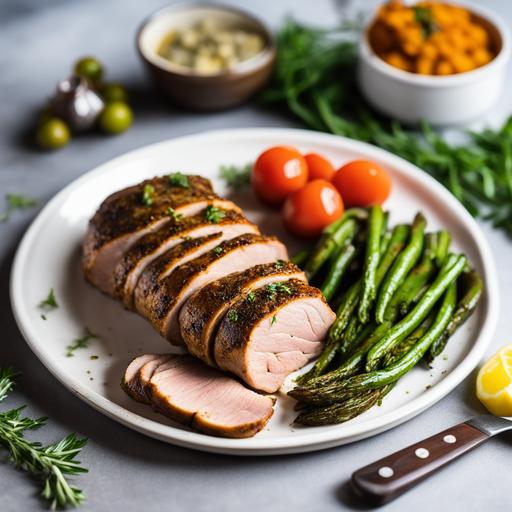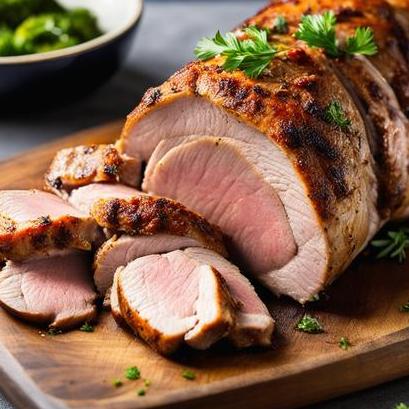
The Ultimate Guide To Whole Pork Tenderloin In The Oven
Pork tenderloin is a delicious and versatile cut of meat that can be prepared in various ways, but cooking it in the oven is one of the simplest and most effective methods. In this article, we will explore the science behind cooking pork tenderloin in the oven, including the optimal temperature and timing for achieving juicy and flavorful results. We will also discuss how to choose the best ingredients and properly prepare them for cooking. Finally, we will provide a step-by-step recipe for preparing a mouthwatering whole pork tenderloin in the oven.
Food Science Of Cooking Whole Pork Tenderloin In An Oven
Cooking pork tenderloin in the oven involves a combination of heat, time, and technique to ensure that the meat is cooked to perfection. Understanding the science behind this process can help you achieve the best results.
Maillard Reaction
One of the key processes that occur when cooking pork tenderloin in the oven is the Maillard reaction. This chemical reaction occurs between amino acids and reducing sugars in the meat when exposed to high heat, resulting in the browning and caramelization of the surface of the meat. This reaction not only enhances the flavor of the pork but also creates a desirable texture.
Denaturation Of Proteins
As the pork tenderloin cooks in the oven, the proteins in the meat undergo a process called denaturation. This involves the unfolding and rearrangement of the protein molecules, leading to changes in texture and tenderness. Cooking the pork tenderloin to the proper internal temperature ensures that the proteins are fully denatured, resulting in a juicy and tender final product.
Rendering Of Fat
Pork tenderloin contains intramuscular fat, which melts during the cooking process. This fat not only adds flavor to the meat but also helps keep it moist and juicy. Cooking the pork tenderloin in the oven allows the fat to slowly render out, resulting in a succulent and flavorful end result.
Choosing Ingredients
Selecting the right ingredients is crucial for creating a delicious pork tenderloin dish. When choosing pork tenderloin, look for cuts that are fresh and well-marbled with intramuscular fat. This marbling will help keep the meat moist and flavorful during cooking.
In addition to the pork tenderloin itself, you will also need to gather ingredients for seasoning and flavoring the meat. Common seasonings for pork tenderloin include garlic, herbs such as rosemary and thyme, and spices such as paprika and black pepper. You may also want to include ingredients for a marinade or glaze, such as soy sauce, honey, or balsamic vinegar.
When selecting herbs and spices, opt for fresh ingredients whenever possible, as they will impart the most vibrant flavors to the pork tenderloin. If fresh herbs are not available, you can use dried herbs instead, but be sure to adjust the quantities accordingly, as dried herbs are more potent than fresh.
Preparing Ingredients

Properly preparing the ingredients is essential for ensuring that your whole pork tenderloin turns out tender, juicy, and full of flavor. Follow these steps to prepare your pork tenderloin for cooking:
Trim Excess Fat
Start by trimming any excess fat from the surface of the pork tenderloin. While some fat is desirable for flavor and juiciness, too much fat can cause the meat to become greasy during cooking.
Season The Pork
Next, season the pork tenderloin generously with your chosen herbs, spices, and seasonings. Rub the seasonings into the surface of the meat, making sure to coat it evenly on all sides. If you are using a marinade or glaze, apply it to the pork tenderloin and allow it to marinate for at least 30 minutes before cooking.
Preheat The Oven
Before cooking the pork tenderloin, preheat your oven to the optimal temperature. For pork tenderloin, a temperature of 375°F (190°C) is ideal. Preheating the oven ensures that the meat cooks evenly and consistently throughout the cooking process.
Optimal Oven Cooking Temperature & Timing
Cooking pork tenderloin in the oven requires careful attention to temperature and timing to ensure that the meat is cooked to perfection. Follow these guidelines for optimal results:
Temperature
Set your oven to 375°F (190°C) for cooking pork tenderloin. This temperature allows the meat to cook evenly while developing a delicious crust on the outside.
Timing
The cooking time for pork tenderloin will vary depending on the size of the cut and the desired level of doneness. As a general rule, plan to cook the pork tenderloin for approximately 20 minutes per pound (450 grams) of meat. Use a meat thermometer to check the internal temperature of the pork tenderloin, aiming for a temperature of 145°F (63°C) for medium-rare or 160°F (71°C) for medium.
Whole Pork Tenderloin Oven Recipe
Now that you understand the science behind cooking pork tenderloin in the oven and how to properly prepare the ingredients, it’s time to put it all together with a delicious recipe. Follow these step-by-step instructions to create a mouthwatering whole pork tenderloin in the oven:
Ingredients
- 1 whole pork tenderloin (about 1.5 to 2 pounds)
- 2 cloves garlic, minced
- 1 tablespoon fresh rosemary, chopped
- 1 tablespoon fresh thyme leaves
- 1 teaspoon paprika
- 1 teaspoon salt
- 1/2 teaspoon black pepper
- 2 tablespoons olive oil
Instructions
-
Preheat your oven to 375°F (190°C).
-
Trim any excess fat from the surface of the pork tenderloin.
-
In a small bowl, combine the minced garlic, chopped rosemary, thyme leaves, paprika, salt, pepper, and olive oil to create a seasoning mixture.
-
Rub the seasoning mixture all over the surface of the pork tenderloin, making sure to coat it evenly on all sides.
-
Place the seasoned pork tenderloin on a roasting pan or baking sheet lined with parchment paper.
-
Roast the pork tenderloin in the preheated oven for approximately 20 minutes per pound (450 grams) of meat, or until the internal temperature reaches 145°F (63°C) for medium-rare or 160°F (71°C) for medium.
-
Once the pork tenderloin is cooked to your desired level of doneness, remove it from the oven and let it rest for 5-10 minutes before slicing.
-
Slice the pork tenderloin into thick slices and serve immediately, garnished with additional fresh herbs if desired.
Cooking a whole pork tenderloin in the oven is a simple yet delicious way to prepare this versatile cut of meat. By understanding the science behind the cooking process and following proper techniques for ingredient selection and preparation, you can create a mouthwatering dish that is sure to impress your family and friends. With the right temperature, timing, and seasoning, you can achieve tender, juicy pork tenderloin with a beautifully caramelized crust every time. So next time you’re craving a hearty and satisfying meal, try making a whole pork tenderloin in the oven—you won’t be disappointed!
Doneness Checks

Before we embark on our culinary journey, let’s familiarize ourselves with the star ingredient: pork tenderloin. Pork tenderloin, often referred to as the "filet mignon of pork," is a lean and tender cut of meat sourced from the muscle that runs along the backbone of the pig. Due to its minimal fat content, pork tenderloin has a mild flavor and a tender texture, making it a favorite among home cooks and professional chefs alike.
When preparing a whole pork tenderloin in the oven, the goal is to achieve a juicy and flavorful interior while ensuring that the exterior develops a delicious crust. This requires careful attention to cooking time and temperature, as well as proper seasoning and preparation techniques.
Achieving the perfect level of doneness is crucial when cooking pork tenderloin. Undercooking can result in tough and chewy meat, while overcooking can lead to dryness and loss of flavor. To ensure that your pork tenderloin is cooked to perfection, consider the following doneness checks:
Internal Temperature
The most reliable way to determine the doneness of pork tenderloin is by using a meat thermometer. The USDA recommends cooking pork to an internal temperature of 145°F (63°C) followed by a three-minute rest time. At this temperature, the pork will be juicy and slightly pink in the center, which is safe to consume according to modern food safety standards.
To measure the internal temperature, insert the thermometer probe into the thickest part of the pork tenderloin, making sure to avoid touching bone or fat. Once the desired temperature is reached, remove the pork from the oven and allow it to rest before slicing.
Visual Inspection
In addition to using a meat thermometer, you can also assess the doneness of pork tenderloin by visual cues. When properly cooked, the exterior of the pork should be golden brown with a caramelized crust, while the interior should be moist and slightly pink. However, keep in mind that visual cues alone may not always be accurate, so it’s best to rely on a meat thermometer for precise results.
Undercooking
Undercooking pork tenderloin can result in an unpleasant eating experience, as the meat may be tough and chewy. To avoid undercooking, follow these tips:
Preheating The Oven
Ensure that your oven is fully preheated to the recommended temperature before placing the pork tenderloin inside. A properly preheated oven will ensure even cooking and help to develop a flavorful crust on the exterior of the meat.
Checking Internal Temperature
Use a meat thermometer to monitor the internal temperature of the pork tenderloin throughout the cooking process. This will allow you to accurately gauge when the pork is cooked to the desired level of doneness.
Adjusting Cooking Time
If you find that your pork tenderloin is undercooked, you can return it to the oven and continue cooking until the desired internal temperature is reached. However, be careful not to overcook the pork in the process.
Overcooking
Overcooking pork tenderloin can result in dry, tough meat that lacks flavor. To prevent overcooking, consider the following tips:
Monitoring Temperature
Keep a close eye on the internal temperature of the pork tenderloin and remove it from the oven as soon as it reaches the recommended temperature of 145°F (63°C). Overcooking can occur rapidly, so it’s important to act quickly once the pork reaches the desired doneness.
Using A Timer
Set a timer to remind yourself to check the pork tenderloin periodically throughout the cooking process. This will help prevent accidentally leaving the pork in the oven for too long.
Resting Period
Allow the pork tenderloin to rest for at least three minutes after removing it from the oven. This allows the juices to redistribute throughout the meat, resulting in a juicier and more flavorful final product.
Troubleshooting

Despite your best efforts, you may encounter some common issues when cooking pork tenderloin in the oven. Here are some troubleshooting tips to help you overcome these challenges:
Dry Pork
If your pork tenderloin turns out dry, it may have been overcooked. To salvage the meat, consider slicing it thinly and serving it with a flavorful sauce or gravy to add moisture.
Tough Texture
Tough pork tenderloin is often the result of undercooking or insufficient resting time. To tenderize the meat, you can try slicing it thinly against the grain, which can help break down tough muscle fibers.
Uneven Cooking
Uneven cooking can occur if the pork tenderloin is not of uniform thickness. To ensure even cooking, you can flatten the thicker end of the tenderloin slightly with a meat mallet before cooking.
Recipe Variations
Now that you’re familiar with the basics of cooking pork tenderloin in the oven, let’s explore some delicious recipe variations to tantalize your taste buds:
Herb-Crusted Pork Tenderloin
Coat the pork tenderloin with a mixture of chopped fresh herbs, such as rosemary, thyme, and parsley, along with garlic and olive oil. Roast in the oven until golden brown and cooked to perfection.
Honey Mustard Glazed Pork Tenderloin
Brush the pork tenderloin with a mixture of honey, Dijon mustard, and soy sauce before roasting in the oven. The glaze will caramelize during cooking, creating a sweet and tangy crust on the exterior of the meat.
Balsamic-Glazed Pork Tenderloin
Marinate the pork tenderloin in a mixture of balsamic vinegar, olive oil, garlic, and brown sugar before roasting in the oven. The vinegar will impart a rich and tangy flavor to the meat, while the brown sugar adds a hint of sweetness.
Cooking a whole pork tenderloin in the oven is a simple yet impressive way to create a delicious and satisfying meal. By following the tips and techniques outlined in this guide, you can achieve perfectly cooked pork tenderloin every time. Whether you prefer it herb-crusted, honey mustard glazed, or balsamic-glazed, the possibilities for flavor variations are endless. So fire up your oven, gather your ingredients, and get ready to enjoy a mouthwatering pork dish that will delight your taste buds and impress your guests.
Flavour Enhancement Tips
Pork tenderloin, often referred to as the "other white meat," is a lean and succulent cut taken from the muscle that runs alongside the backbone of the pig. It’s a popular choice for many home cooks due to its tenderness and mild flavor. Cooking a whole pork tenderloin in the oven is a straightforward process that yields delicious results.
Enhancing the flavor of pork tenderloin starts with selecting high-quality meat. Look for tenderloins that are pinkish-red in color with a small amount of marbling. Marbling refers to the thin streaks of fat that run through the meat, adding flavor and juiciness.
Before cooking, consider marinating the pork tenderloin to infuse it with additional flavor. A simple marinade can be made using a combination of olive oil, garlic, herbs (such as rosemary or thyme), and acidic ingredients like lemon juice or vinegar. Marinating the pork for at least 30 minutes, or even overnight, will help tenderize the meat and impart delicious flavor.
Another way to enhance the flavor of pork tenderloin is by using a dry rub. A blend of spices such as paprika, garlic powder, onion powder, cumin, and brown sugar can create a flavorful crust on the outside of the meat. Rub the spice mixture onto the pork tenderloin before cooking for an added burst of flavor.
Texture Enhancement Tips

While pork tenderloin is naturally tender, there are a few techniques you can use to ensure it stays juicy and succulent during cooking. One method is to brine the pork tenderloin before cooking. Brining involves soaking the meat in a solution of water, salt, and sugar for several hours. This helps the meat retain moisture during cooking, resulting in a juicier end product.
Another technique for enhancing the texture of pork tenderloin is to sear it before roasting in the oven. Searing the meat in a hot skillet caramelizes the surface, creating a flavorful crust and locking in juices. To sear the pork tenderloin, heat a skillet over medium-high heat, add a small amount of oil, and sear the meat on all sides until golden brown.
Cooking At Different Temperatures
The cooking temperature for pork tenderloin can vary depending on personal preference and desired doneness. A common method is to roast the pork tenderloin in a preheated oven at 375°F (190°C). This temperature allows the meat to cook evenly without drying out, resulting in a tender and juicy interior.
For those who prefer their pork tenderloin slightly pink in the center, aim for an internal temperature of 145°F (63°C). Use a meat thermometer inserted into the thickest part of the tenderloin to ensure accuracy. Once the desired temperature is reached, remove the pork from the oven and let it rest for a few minutes before slicing.
If you prefer your pork tenderloin more well-done, you can cook it to an internal temperature of 160°F (71°C). Keep in mind that cooking the meat to this temperature may result in slightly less juiciness, so be mindful not to overcook it.
Cooking Tips
When cooking a whole pork tenderloin in the oven, there are a few additional tips to keep in mind to ensure success:
-
Trimming: Before cooking, trim any excess fat or silver skin from the pork tenderloin. This will help prevent the meat from becoming tough during cooking.
-
Resting: Allow the pork tenderloin to rest for 5-10 minutes after cooking before slicing. This allows the juices to redistribute throughout the meat, resulting in a juicier end product.
-
Basting: While optional, basting the pork tenderloin with pan juices or marinade during cooking can add flavor and moisture to the meat.
-
Using a Roasting Rack: Placing the pork tenderloin on a roasting rack in the oven allows air to circulate around the meat, ensuring even cooking and preventing the bottom from becoming soggy.
Serving Suggestions
Once your pork tenderloin is cooked to perfection, it’s time to serve it up! Here are some serving suggestions to complement this delicious dish:
-
Sides: Pair the pork tenderloin with your favorite side dishes such as roasted vegetables, mashed potatoes, or a fresh green salad.
-
Sauces: Serve the pork tenderloin with a flavorful sauce such as creamy mushroom sauce, apple cider glaze, or tangy barbecue sauce.
-
Garnishes: Sprinkle chopped fresh herbs such as parsley or chives over the sliced pork tenderloin for a pop of color and added freshness.
-
Wine Pairing: Pair the pork tenderloin with a glass of red or white wine that complements the flavors of the dish. For example, a light-bodied Pinot Noir or a crisp Sauvignon Blanc would be excellent choices.
Conclusion
Cooking a whole pork tenderloin in the oven is a simple yet satisfying way to create a delicious meal. By following the tips and techniques outlined in this guide, you can ensure that your pork tenderloin turns out tender, juicy, and flavorful every time. Whether you’re cooking for a weeknight dinner or a special occasion, this versatile cut of meat is sure to impress your family and friends. So fire up your oven, gather your ingredients, and enjoy the mouthwatering goodness of roasted pork tenderloin!



